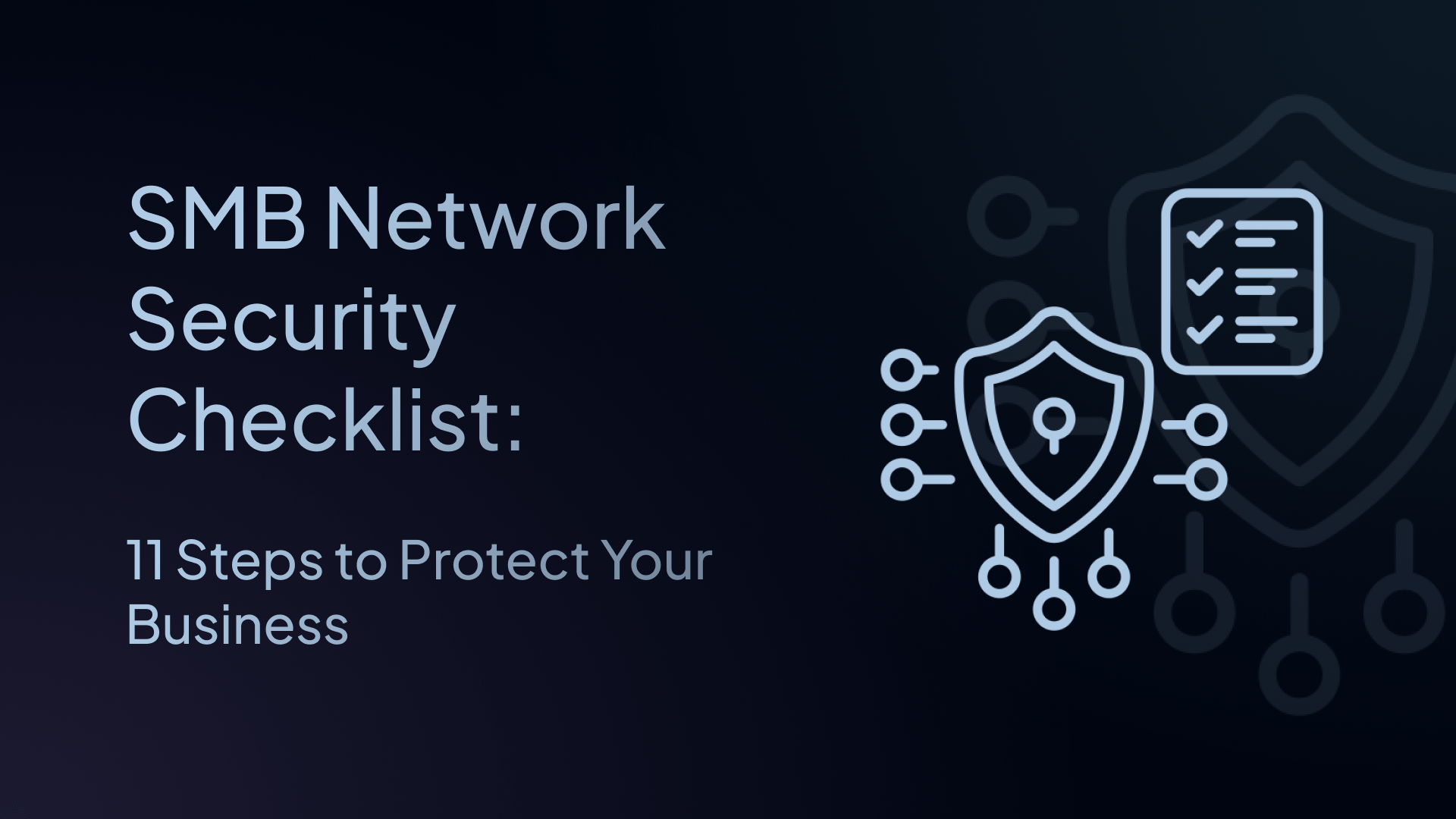SMB Network Security Checklist: 11 Steps to Protect Your Business
Protect your SMB with 11 actionable steps to secure devices, data, and users – including DNS-level protection with Control D.

Small and mid-sized businesses (SMBs) are prime targets for cyberattacks. It’s not because they’re high-value, but because they’re often underprotected.
This step-by-step network security checklist covers the core safeguards every SMB should implement, from firewalls and patching to DNS security, so you can build a resilient, budget-friendly defense stack.
Why SMBs Are Prime Targets for Cyber Attacks
Cybercriminals see SMBs as low-hanging fruit. Why?
- Fewer security controls
- Lack of dedicated security staff
- Slower patching and updates
- Relying on off-the-shelf routers, unmanaged DNS, or outdated firewalls and antivirus software
- May not have visibility into network activity
- More likely to fall for phishing and social engineering
Attackers know this, and they take advantage of it.
That’s why it’s critical to put a holistic security strategy in place — one that covers the entire attack surface, from endpoints to DNS traffic to user behavior.
SMB Network Security Checklist: 11 Key Steps for Full Protection
Use this checklist to evaluate and strengthen your organization's security posture. Whether you're starting from scratch or tuning an existing setup, each category includes key steps, recommended practices, and built-in opportunities to improve over time.
✅ 1. Conduct a Network Risk Assessment
Before you implement any tools, know what you’re securing.
Checklist:
- Take inventory of all hardware: laptops, desktops, servers, printers, routers, etc.
- Document all software and cloud apps in use
- Label critical assets (e.g., finance systems, CRMs, IP repositories)
- Identify all users, devices, and access levels
- Review vendor and third-party integrations
- Assess your most vulnerable entry points
Tip: Gain visibility into DNS requests made by devices across your network. Suspicious activity often begins with DNS; spotting it early can help prevent compromise.
✅ 2. Implement Firewalls and Perimeter Security
The perimeter is your first line of defense – blocking unauthorized traffic and filtering what enters and exits your network.
Checklist:
- Use a hardware firewall for your entire office network
- Deploy host-based firewalls on workstations and servers
- Segment your network (e.g., guest Wi-Fi vs. internal systems)
- Configure alerts for unusual traffic spikes
For remote workers, make sure VPNs or Zero-Trust Network Access (ZTNA) solutions are in place to control how they reach internal tools.
Tip: SMB routers with built-in firewalls are often underpowered and outdated. Consider using a dedicated firewall appliance or cloud-managed security gateway.
✅ 3. Patch Management
Outdated software and firmware are gold mines for attackers.
Checklist:
- Enable automatic OS and software updates for routers, endpoints, firewalls, etc.,
- Regularly patch third-party applications (e.g., Zoom, Adobe, Chrome)
- Disable unused services or ports
- Change all default passwords and usernames
- Enable 2FA wherever possible
- Track software versions and update status in your inventory
- Test critical patches in a staging environment when possible
Tip: Automate what you can. Tools like Microsoft Intune or RMM software can streamline patching across your fleet.
✅ 4. Deploy Endpoint Security
Each laptop, desktop, or mobile device is a potential entry point.
Checklist:
- Install up-to-date antivirus or EDR software on all endpoints
- Enable full disk encryption
- Prevent fileless malware
- Block lateral movement
- Block high-risk apps and browser extensions
Tip: Look for EDR (Endpoint Detection & Response) solutions that provide insight into incidents and support remote isolation if a device is compromised.
✅ 5. Train Employees on Security Awareness
Training employees on security awareness and best practices is just as important as implementing the best security tools.
Checklist:
- Teach the basics: strong passwords (password manager), MFA, phishing, and physical security
- Provide security awareness training at least twice per year
- Simulate phishing attacks
- Reinforce policies around remote access and app installs
- Encourage a no-blame culture for honest mistakes
- Make it easy to report security concerns
- Include cybersecurity in onboarding and offboarding processes
Tip: Reinforce training with real-world examples. If Control D blocks a phishing domain, use that as a teachable moment.
✅ 6. Secure Your DNS Layer
Your DNS is the gateway to everything online – and the first place malicious traffic flows through. Route all DNS traffic through a secure resolver, e.g., Control D, as this can help:
- Blocks malicious and phishing domains in real time
- Prevents access to risky content categories (e.g., crypto, adult content, torrents, piracy)
- Enforces policy controls per device, user, team, or company-wide
- Stops malware communication before it reaches endpoints
- Uses encrypted DNS to prevent tampering
- Provides logs and insights into device behavior across your network
Tip: Control D offers real-time threat feeds, per-device policies, and exportable logs – all without installing agents or buying hardware.
✅ 7. Access Controls and User Privileges
Too much access is just as dangerous as too little protection.
Checklist:
- Enforce least-privilege access for all users
- Use unique credentials – no shared logins
- Require multi-factor authentication (MFA) everywhere
- Periodically review and remove stale accounts
- Log all access to sensitive systems or apps
Tip: Combine access control with DNS filtering – only allow certain groups to access specific categories of websites or services.
✅ 8. Backup and Disaster Recovery
Even with the best defenses, things can go wrong. Be ready.
Checklist:
- Maintain regular backups of all critical data. Follow the 3-2-1 Rule:
- 3 copies of your data
- 2 different storage formats (e.g., local NAS + cloud)
- 1 offsite or offline
- Test restore procedures quarterly – a backup that can’t be restored is worthless
- Keep backup systems isolated from production networks
- Document and rehearse your disaster recovery process
Tip: Ransomware targets backups. Keep at least one copy off-site or immutable so it can't be altered.
✅ 9. Email Security and Phishing Protection
Email is one of the top vectors for attacks, especially phishing.
Checklist:
- Use a secure email gateway or spam filter
- Enable DMARC, SPF, and DKIM for email authentication
- Train employees to recognize phishing attempts
- Conduct quarterly phishing simulation exercises
- Encourage reporting, not shaming, when someone clicks a bad link
Tip: Control D can act as a safety net by blocking access to phishing domains even if a user clicks a malicious link.
✅ 10. Logging and Monitoring
You can’t protect what you can’t see.
Checklist:
- Enable logging on all network devices and servers
- Use a centralized log management tool or SIEM
- Monitor for abnormal login attempts, spikes, or odd queries
- Review DNS logs regularly for malware, tunneling, or botnet behavior
Tip: Control D provides detailed logs of DNS queries and blocks across every device, including IoT and unmanaged hardware that can’t run traditional endpoint software, giving you immediate visibility into network activity across all users and devices.
✅ 11. Have an Incident Response Plan (IRP)
Even with great defenses, incidents happen. Be prepared.
- Designate roles and responsibilities
- Outline steps to isolate and contain breaches
- Document procedures for contacting vendors, clients, and authorities
- Practice tabletop exercises quarterly
Tip: Control D supports rapid response by letting you instantly block or redirect domains, identify affected devices via logs, and create emergency DNS rules to lock down traffic.
How Control D Complements Your SMB Security Stack
Let’s summarize why Control D is a must-have for any SMB’s cybersecurity plan:
| Feature | Benefit |
|---|---|
| DNS-level malware and phishing protection | Blocks threats before they reach endpoints |
| Cloud-based and agentless | No installs, no hardware, works on all devices |
| Device and user-based policy rules | Enforce different policies for teams, branches, or guest Wi-Fi |
| Geo and IP-based filtering | Block access from risky regions or unknown IPs |
| Custom blocklists and allowlists | Tailor filtering to your industry or business needs |
| Logging and analytics | Know exactly who is accessing what and when, in real time |
Whether you’re managing a small legal office, a remote-first SaaS company, or a retail franchise with dozens of stores, Control D gives you enterprise-grade DNS security without the enterprise bloat or budget.
Common SMB Security Pitfalls to Avoid
Even with the best intentions, many SMBs fall into avoidable traps. Watch out for:
- Using consumer-grade hardware for business networks
- “Set it and forget it” setups
- Overreliance on a single IT person with no redundancy
- Neglecting DNS traffic visibility, assuming it's "just working"
By keeping this checklist in rotation and assigning clear ownership, you can build a repeatable, audit-ready security routine.
Final Thoughts
This checklist gives you a solid roadmap to building a resilient and secure network for your SMB, one that protects your people, data, and reputation.
With the right mix of proactive security and DNS visibility, even the leanest SMB team can defend against modern threats.
Control D gives you the tools to filter malicious traffic, log DNS events, and apply custom policies without agents, contracts, or complexity.


